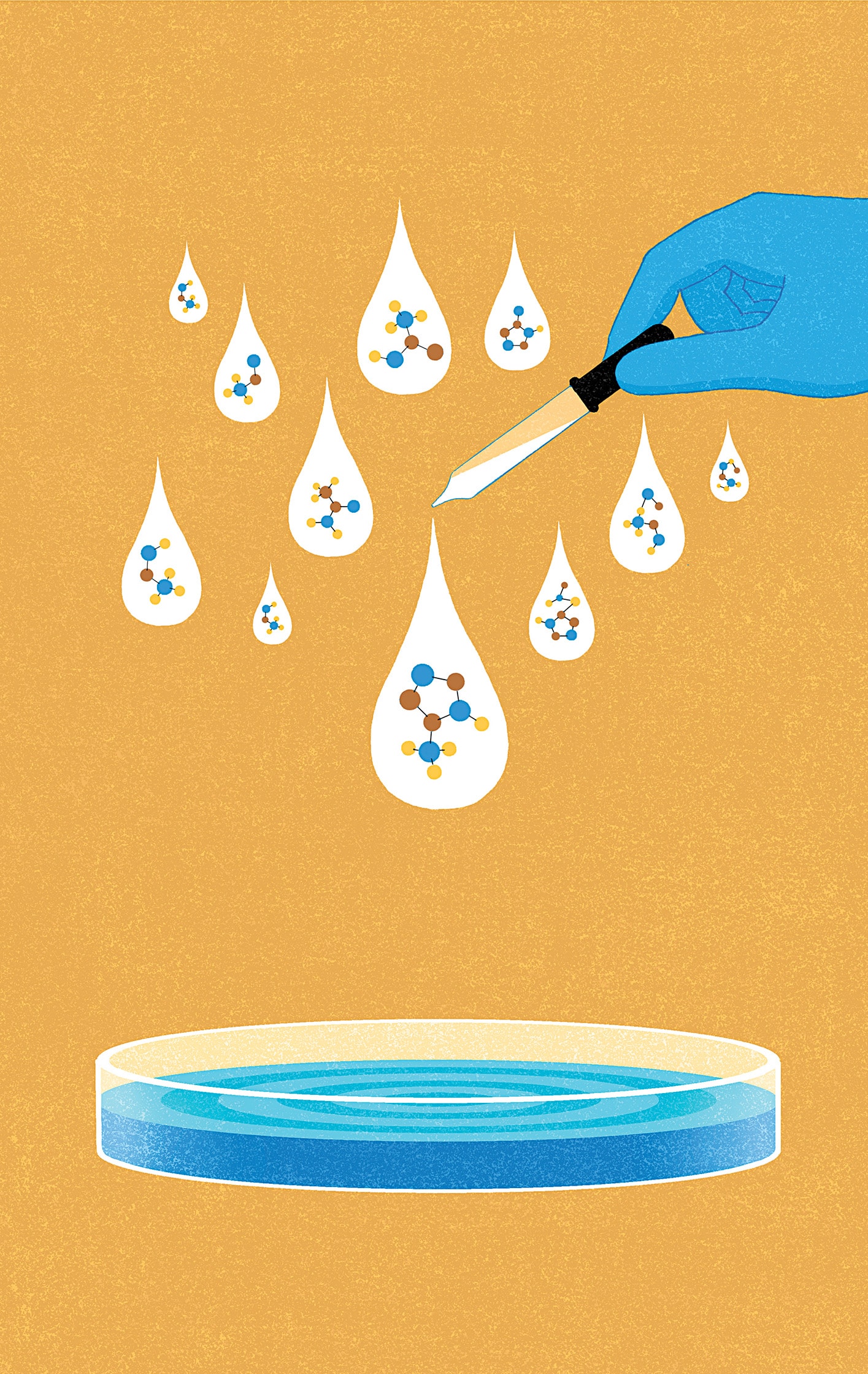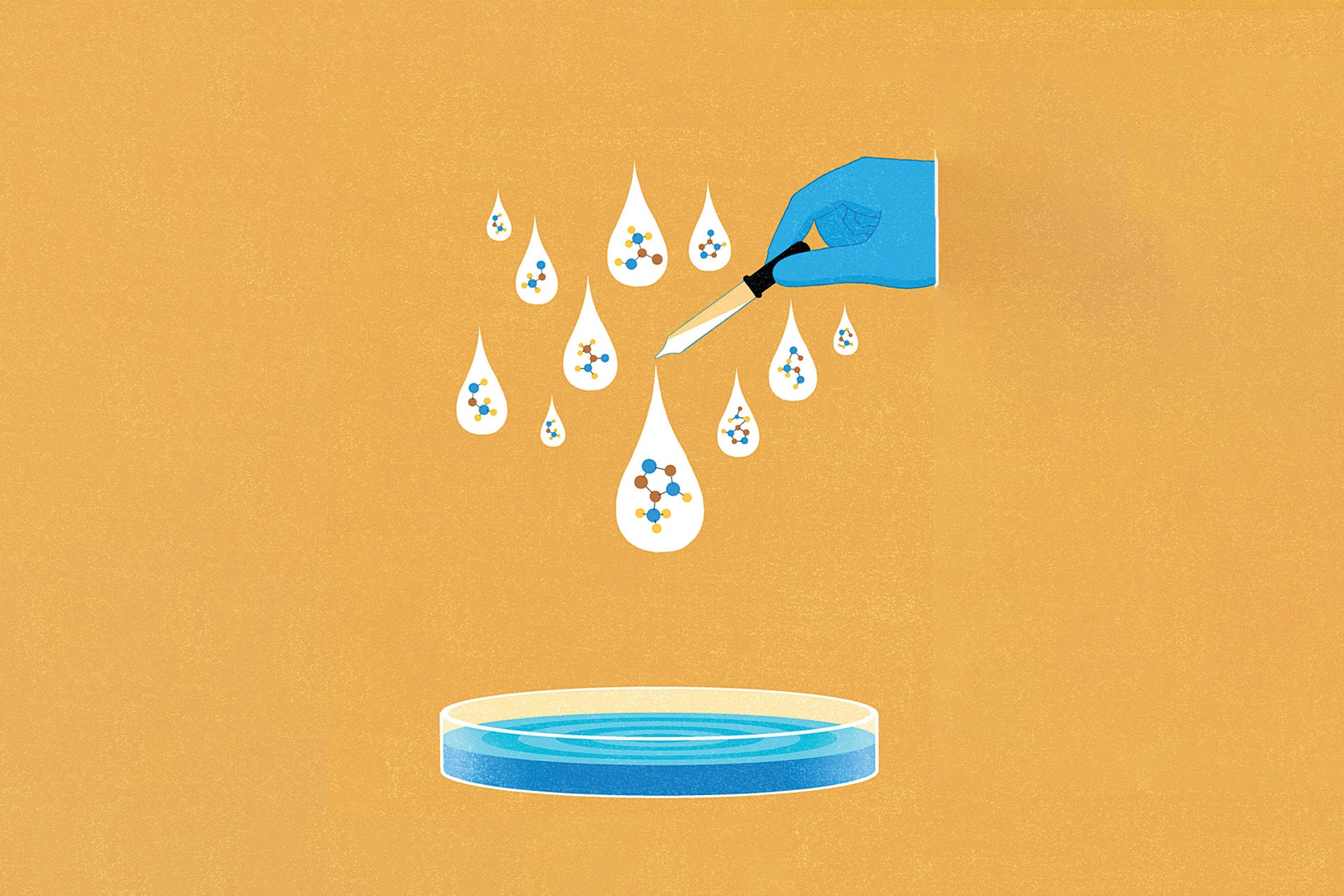Therapeutic
Matchmaking
An innovative program tests tumors against hundreds of drugs in a search for new therapies for patients with advanced cancers
By Josh Baxt
Illustration by James Steinberg
Coming in to work one morning last spring, Ines Lohse, Ph.D., an assistant scientist at the Center for Therapeutic Innovation (CTI) at the Miller School of Medicine, found the red light on her office telephone lit, indicating that she had missed calls. When she lifted the receiver to retrieve them, she discovered that she didn’t have two or three missed calls — she had more than 500.
Almost all the calls were from the parents of children who were desperately ill with some type of cancer. Dr. Lohse had just returned from a conference where she had spoken about the CTI’s novel program in which scientists try to match tumor samples to more than 200 FDA-approved drugs in an effort to offer new treatment options to patients who have exhausted standard therapies. She handed out a few business cards, the word spread, and her phone began ringing.
Dr. Lohse had additional calls on her cell phone. She says she listened to messages and spoke with a number of the callers, spending the better part of two days on the phone.
“You could hear the desperation in their voices,” Dr. Lohse said, “and you have to be careful not to give them false hope. What we are doing is highly experimental. We are bound by protocols, and we can only accept certain patients. Most did not qualify because they had not yet tried all of the standard treatments, or they had no means, such as through upcoming surgery, to obtain tumor material.”
Over the past 50 years, oncologists have developed a complex manual to address cancer. These national standards guide treatment based on a tumor’s organ of origin, genomic mutations and other factors. With these inputs, an oncology team can recommend chemotherapies, targeted treatments, immunotherapy, surgery, radiation or all of the above.
If the cancer comes back, there are usually second-line treatments and then even thirdline approaches. But at some point, depending on the type and nature of the malignancy, the cancer overcomes the standard of care and patients run out of options. Oncologists call those cancers refractory.
From there, choosing treatments is as much guesswork as science. Clinicians can sequence a tumor’s genome to identify its driving mutations, but an advanced cancer could have many, making it difficult to know which ones to target.
“Few cancers are amenable to being fixed by a drug against a single driver,” said Claes Wahlestedt, M.D., Ph.D., professor, CTI director and associate dean for therapeutic innovation. “Those cases are probably almost all exhausted — we are stuck with cancers that are more complex.”
But now, to better manage refractory cancers, researchers and clinicians at Sylvester Comprehensive Cancer Center, which was recently named a National Cancer Institute-designated cancer center, are trying a different approach — testing tumor samples against hundreds of potential treatments.
“Far too often the cancer comes back and the physician has no clear idea what to do,” Dr. Wahlestedt said. “Genetic testing doesn’t give you the answer. Why not test every available drug the doctor, in theory, could give the patient? For people who have exhausted standard of care, it’s a logical option.”
“In a few cases, we have been able to find a match and provide viable treatment options. For me … an outcome like that is incredibly rewarding.”
— Shaun Brothers, Ph.D.

There’s nothing new about testing potential treatments on patient samples. But cancers are much more complex than most conditions, and applying this approach to tumors is no small task. The Sylvester team is the first to take a comprehensive approach to the problem.
The protocol tests 215 drugs — chemos, targeted therapies, experimental treatments — against a patient’s tumors to see if any will slow the cancer. They deliver each in multiple concentrations to identify the most effective.
“We take a piece of the tumor, or a bone marrow biopsy, purify the cancer cells and seed them on 384-well plates where we treat with the anti-cancer agents,” Dr. Lohse said. “We then wait and measure cell survival. The data is analyzed using an algorithm developed here to come up with rank-ordered treatment suggestions.”
The system took nearly five years to develop. The team needed to build a complex infrastructure to manage patient samples, work with distant physicians, handle the statistics, conduct research and perform other tasks.
“We have to get cells from the patient, and we need enough cells to run all the drug screening assays,” Dr. Wahlestedt said. “Logistically it’s nothing you set up in an afternoon.”
The end product is a list of potential treatments, starting with the ones that were most effective in testing.
“There might be five or 45 compounds to choose from,” said Shaun Brothers, Ph.D., who directs the Molecular Therapeutics Shared Resource at Sylvester. “Physicians select drugs from this list based on access and other factors. The FDA drugs are all available under compassionate care.”
“There might be five or 45 compounds to choose from,” said Shaun Brothers, Ph.D., who directs the Molecular Therapeutics Shared Resource at Sylvester. “Physicians select drugs from this list based on access and other factors. The FDA drugs are all available under compassionate care.”
The team started with acute myeloid leukemia patients, generally people over 60. The basic AML protocol hasn’t changed much in 50 years, and can be quite problematic, as older patients don’t always tolerate the intense chemotherapy.
In a small trial of 12 people who had exhausted standard therapies, the assay found treatments for four patients, three of whom responded favorably, a tremendous feat.
Later, the group tested their approach on sarcomas, connective tissue cancers that often affect children. The pediatric population carries the highest burden from a sarcoma diagnosis due to loss of limbs, pain and treatment-induced side effects such as loss of fertility, heart or lung problems and learning and development issues.
“We have had patients who were getting ready to die,” Dr. Brothers said. “In a few cases, we have been able to find a match and provide viable treatment options. For me, both professionally and personally, an outcome like that is incredibly rewarding.”
The team tries to accept as many patients as possible, but sometimes, as Dr. Lohse learned from so many of her callers, there isn’t tumor material — or enough of it — available for the test. In addition, they are working on a shoestring budget, with some funding from private foundations.
“We scrimp and scrape and try to find money wherever we can,” Dr. Brothers said. “It has been quite a challenge.”
Despite these barriers, Sylvester is committed to the program and has received encouragement from oncologists around the country who don’t have access to these types of sophisticated tools.
The group recognizes this is a powerful way to help patients who have exhausted the standard of care and are working to expand access. They are now screening patients with multiple myeloma and ovarian cancer, and are preparing to begin a large, multicenter clinical trial for AML. More clinical evidence could encourage other cancer centers to adopt the protocol.
“The ultimate goal is to help as many people as we possibly can,” Dr. Brothers said.![]()



